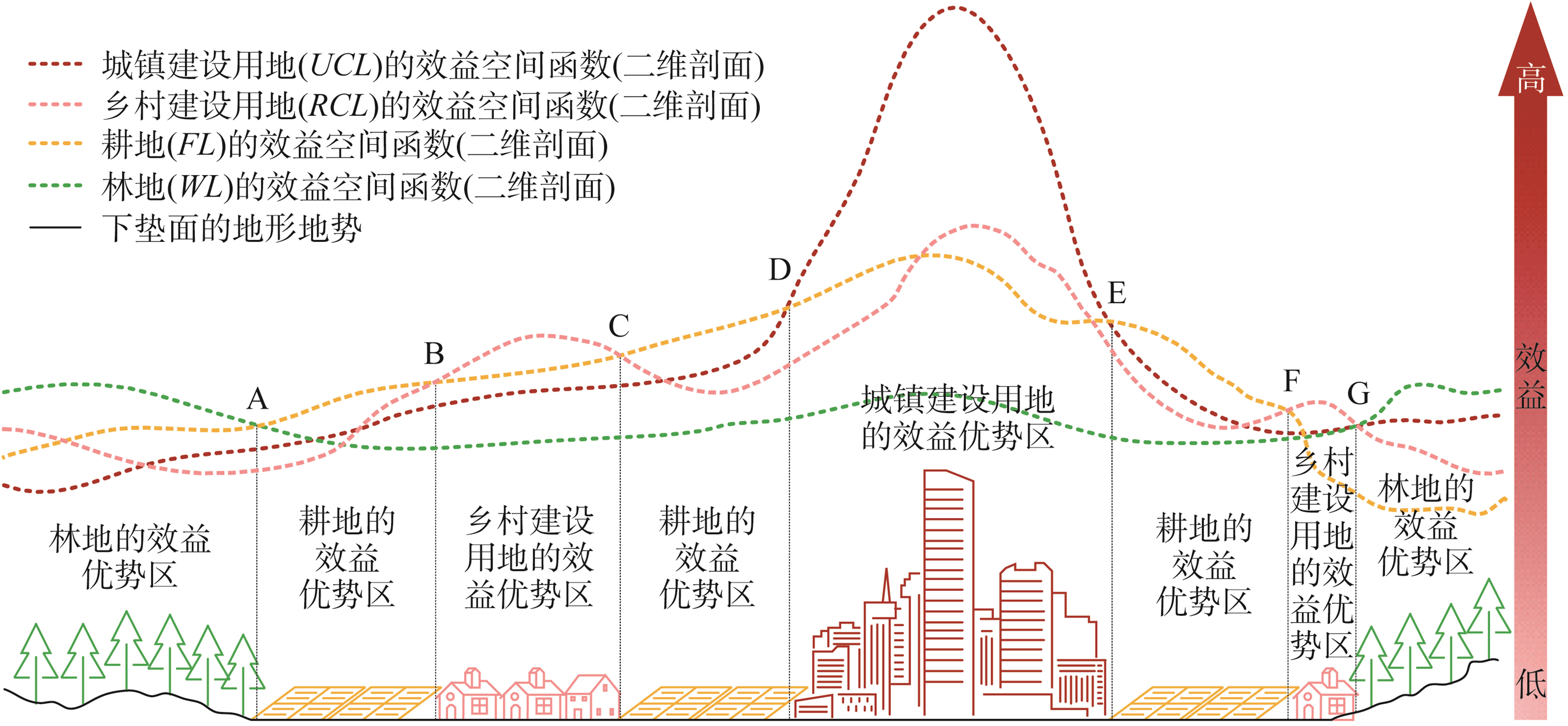

土地利用转型机理与国土空间格局优化——基于土地利用效益空间函数视角的分析
|
周贵鹏(1999- ),男,江西永新人,博士研究生,研究方向为土地利用转型与城乡发展。E-mail: zhouguipeng20@mails.ucas.ac.cn |
收稿日期: 2023-03-27
修回日期: 2023-06-21
网络出版日期: 2023-10-13
基金资助
国家自然科学基金项目(41971216)
The mechanism of land use transitions and optimization of territorial spatial development patterns: Analysis based on the spatial functions of land use benefits
Received date: 2023-03-27
Revised date: 2023-06-21
Online published: 2023-10-13
土地利用转型是追求用地效益最大化的过程。运用理论分析、文献研究和案例实证法,从土地利用效益空间函数视角,探讨土地利用及其转型机理、土地利用形态的“协调—冲突—协调”交替演化模式和用地转型对国土空间格局优化的作用等。结论如下:(1)土地利用效益空间函数反映区域各地类的效益产出格局,并决定各地类的效益相对优势区。(2)区域土地利用转型的机理可概括为“三维原始动力—隐性形态变化—效益函数变化—空间冲突协调—显性形态变化”。土地利用转型追求区域用地隐性形态和“自然环境—经济社会—管理体制”的最佳耦合,以及用地显性形态和土地利用效益空间函数的最佳耦合,将各地类在空间上的强冲突化为弱冲突,并趋近实现最大效益总量。(3)土地利用形态“协调—冲突—协调”交替演化的上游和驱使环节是土地利用效益空间函数的变化,其下游响应是土地利用的最终效益产出,土地利用转型是上述交替演化的长期结果。区域土地利用形态的效益产出量是特定土地利用形态与特定经济社会发展阶段相对应、挂钩的纽带。(4)土地利用转型在较小区域与尺度上对国土空间格局优化具有服务优势,且需与更大尺度的国土空间规划交互衔接进而协同实现优化效应。

周贵鹏 , 龙花楼 . 土地利用转型机理与国土空间格局优化——基于土地利用效益空间函数视角的分析[J]. 自然资源学报, 2023 , 38(10) : 2447 -2463 . DOI: 10.31497/zrzyxb.20231002
Land use transitions are the processes of pursuing the maximization of land use benefits. Using theoretical analysis, literature research and case study method, the land use, mechanism of land use transitions, the "coordination-conflict-coordination" alternating evolution mode of land use morphology and the optimization effects of land use transitions on territorial spatial development patterns are discussed from the perspective of the spatial functions of land use benefits. The conclusions are as follows: (1) The spatial function of land use benefits reflects the pattern of output of regional land use benefits. The spatial function of land use benefits of each land use type jointly determines the benefits relative advantage areas of each land use type. (2) The action path of regional land use transitions from underlying to surface can be summarized as "three-dimensional original driving forces-recessive morphology changes-benefits functions changes-spatial conflict and coordination-dominant morphology changes". Land use transitions pursue not only the optimal coupling between the recessive morphology of regional land use and the "natural environment-economic society-management system" (recessive morphology optimization), but also the optimal coupling between the dominant morphology of land use and the spatial functions of land use benefits (dominant morphology optimization), thus transforming the strong spatial conflicts of land use types into weak conflicts (coordination), and close to achieving the maximum total benefits of land use morphology (benefits optimization). (3) The changes of the spatial functions of land use benefits are the upper reaches and driving link of the "coordination-conflict-coordination" alternating evolution of land use morphology, the final benefits output of land use is its downstream response, and land use transitions are the long-term result of the above alternating evolution. The total benefits output of regional land use morphology is the bond and link between specific land use morphology and specific socio-economy development stage. (4) Land use transitions have service advantages for the optimization of territorial spatial patterns in smaller regions and scales, and need to interact and connect with the larger scale of territorial spatial planning to realize the optimization effects.

| [1] |
龙花楼. 论土地利用转型与土地资源管理. 地理研究, 2015, 34(9): 1607-1618.
[
|
| [2] |
刘彦随. 现代人地关系与人地系统科学. 地理科学, 2020, 40(8): 1221-1234.
[
|
| [3] |
龙花楼. 土地利用转型的解释. 中国土地科学, 2022, 36(4): 1-7.
[
|
| [4] |
|
| [5] |
|
| [6] |
|
| [7] |
龙花楼, 李秀彬. 区域土地利用转型分析: 以长江沿线样带为例. 自然资源学报, 2002, 17(2): 144-149.
[
|
| [8] |
龙花楼. 中国农村宅基地转型的理论与证实. 地理学报, 2006, 61(10): 1093-1100.
[
|
| [9] |
|
| [10] |
龙花楼. 论土地利用转型与乡村转型发展. 地理科学进展, 2012, 31(2): 131-138.
[
|
| [11] |
吕晓, 黄贤金, 张全景. 城乡建设用地转型研究综述. 城市规划, 2015, 39(4): 105-112.
[
|
| [12] |
宋小青. 论土地利用转型的研究框架. 地理学报, 2017, 72(3): 471-487.
[
|
| [13] |
胡守庚, 童陆亿, 龙花楼. 论土地利用转型潜力及其评价的理论框架. 地理研究, 2019, 38(6): 1367-1377.
[
|
| [14] |
李灿. 区域土地利用转型诊断与调控的分析路径. 地理研究, 2021, 40(5): 1464-1477.
[
|
| [15] |
|
| [16] |
龙花楼, 陈坤秋. 基于土地系统科学的土地利用转型与城乡融合发展. 地理学报, 2021, 76(2): 295-309.
[
|
| [17] |
谭林, 陈岚. 乡村空间重构与土地利用转型耦合机制及路径分析. 自然资源学报, 2022, 37(7): 1829-1847.
[
|
| [18] |
|
| [19] |
瞿诗进, 胡守庚, 李全峰. 中国城市建设用地转型阶段及其空间格局. 地理学报, 2020, 75(7): 1539-1553.
[
|
| [20] |
|
| [21] |
张佰林, 高江波, 高阳, 等. 中国山区农村土地利用转型解析. 地理学报, 2018, 73(3): 503-517.
[
|
| [22] |
|
| [23] |
约翰·冯·杜能. 孤立国同农业和国民经济的关系. 吴衡康译. 北京: 商务印书馆, 2017: 315-318.
[
|
| [24] |
李秀彬. 土地利用变化的解释. 地理科学进展, 2002, 21(3): 195-203.
[
|
| [25] |
严金明. 简论土地利用结构优化与模型设计. 中国土地科学, 2002, 16(4): 20-25.
[
|
| [26] |
|
| [27] |
唐永超, 王成新, 王瑞莉, 等. 基于精明发展的城市扩张与土地利用效益的耦合研究: 以济南市主城区为例. 人文地理, 2020, 35(4): 91-98.
[
|
| [28] |
|
| [29] |
|
| [30] |
|
| [31] |
王雨晴, 宋戈. 城市土地利用综合效益评价与案例研究. 地理科学, 2006, 26(6): 743-748.
[
|
| [32] |
王国刚, 刘彦随, 方方. 环渤海地区土地利用效益综合测度及空间分异. 地理科学进展, 2013, 32(4): 649-656.
[
|
| [33] |
史进, 黄志基, 贺灿飞, 等. 中国城市群土地利用效益综合评价研究. 经济地理, 2013, 33(2): 76-81.
[
|
| [34] |
|
| [35] |
田俊峰, 王彬燕, 王士君. 东北三省城市土地利用效益评价及耦合协调关系研究. 地理科学, 2019, 39(2): 305-315.
[
|
| [36] |
胡毅, 乔伟峰, 万懿, 等. 江苏省县域土地利用效益综合评价及其分异特征. 经济地理, 2020, 40(11): 186-195.
[
|
| [37] |
|
| [38] |
罗罡辉, 吴次芳. 城市用地效益的比较研究. 经济地理, 2003, 23(3): 367-370, 392.
[
|
| [39] |
毕宝德. 土地经济学. 北京: 中国人民大学出版社, 2001: 63-80.
[
|
| [40] |
彭建, 蒋依依, 李正国, 等. 快速城市化地区土地利用效益评价: 以南京市江宁区为例. 长江流域资源与环境, 2005, 14(3): 304-309.
[
|
| [41] |
樊杰. 人地系统可持续过程、格局的前沿探索. 地理学报, 2014, 69(8): 1060-1068.
[
|
| [42] |
丁明磊, 杨晓娜, 赵荣钦, 等. 碳中和目标下的国土空间格局优化: 理论框架与实践策略. 自然资源学报, 2022, 37(5): 1137-1147.
[
|
| [43] |
贾克敬, 何鸿飞, 张辉, 等. 基于“双评价”的国土空间格局优化. 中国土地科学, 2020, 34(5): 43-51.
[
|
| [44] |
周道静, 徐勇, 王亚飞, 等. 国土空间格局优化中的“双评价”方法与作用. 中国科学院院刊, 2020, 35(7): 814-824.
[
|
| [45] |
|
| [46] |
陈明星, 梁龙武, 王振波, 等. 美丽中国与国土空间规划关系的地理学思考. 地理学报, 2019, 74(12): 2467-2481.
[
|
| [47] |
岳文泽, 韦静娴, 陈阳. 国土空间开发适宜性评价的反思. 中国土地科学, 2021, 35(10): 1-10.
[
|
| [48] |
樊杰. 主体功能区战略与优化国土空间开发格局. 中国科学院院刊, 2013, 28(2): 193-206.
[
|
| [49] |
肖金成, 欧阳慧. 优化国土空间开发格局研究. 经济学动态, 2012, (5): 18-23.
[
|
| [50] |
|
| [51] |
沈体雁, 温璐歌. 基于SCGE的国土空间规划模拟框架CTSPM及其在国土空间安全模拟仿真中的应用. 自然资源学报, 2021, 36(9): 2320-2334.
[
|
| [52] |
黄贤金. 自然资源产权改革与国土空间治理创新. 城市规划学刊, 2021, (2): 53-57.
[
|
| [53] |
|
| [54] |
|
| [55] |
周贵鹏, 龙花楼. 农村居民点土地利用隐性形态三维测度及其耦合协调演化研究: 以河南省为例. 地理科学进展, 2023, 42(6): 1082-1097.
[
|
| [56] |
田俊峰, 王彬燕, 王士君. 东北地区土地利用转型特征测度与机制探索. 经济地理, 2020, 40(9): 184-195.
[
|
/
| 〈 |
|
〉 |